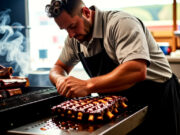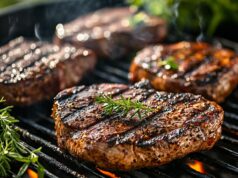- Key Takeaways:
- Selecting the Right Cuts: The Foundation of Flavor
- Preparation Techniques: Marinating and Seasoning
- Temperature Control: The Key to Perfection
- Grilling Techniques for Optimal Results
- Grilling Times and Techniques for Different Cuts
- The Art of Resting: Why Letting Your Steak Relax Matters
- Achieving the Perfect Charcoal-Grilled Flavor
- Common Mistakes to Avoid When Grilling Steaks
- FAQs about Grilling Steaks
- Frequently Asked Questions
Grilling the perfect BBQ steak is an art form that combines skill, technique, and a dash of passion.
Whether you’re a seasoned pitmaster or just starting out, understanding the nuances of selecting the right cut, mastering temperature control, and employing proper grilling techniques can elevate your steaks from average to extraordinary.
This guide offers essential tips and tricks, ensuring juicy, flavorful results every time.
Get ready to impress your friends and family with BBQ steaks that truly shine!
Key Takeaways:

- Choose the right cuts of meat for juicy and flavorful BBQ steaks.
- Proper preparation techniques, such as marinating and seasoning, are crucial for delicious results.
- Master temperature control and grilling techniques for perfectly cooked steaks every time.
Selecting the Right Cuts: The Foundation of Flavor
Selecting the appropriate cut of steak is essential for achieving optimal flavor and texture in barbecuing. Cuts such as ribeye, known for its marbling and tenderness, and sirloin, a leaner option with a robust flavor, offer distinct grilling experiences that can significantly influence the final outcome of the meal.
For those desiring a rich, beefy flavor, flank steak is an excellent choice, particularly suitable for marinades and quick grilling over high heat. Hanger steak, often referred to as the butcher’s cut, is valued for its intense flavor and is best cooked to medium-rare to preserve its juiciness. Skirt steak, characterized by its long and flat shape, excels in stir-fries or fajitas and requires a high-heat sear to achieve optimal tenderness.
For a melt-in-your-mouth experience, filet mignon is renowned for its buttery softness and pairs exceptionally well with simple seasonings that allow its natural flavor to take center stage, making it an ideal choice for a sophisticated barbecue feast.
Preparation Techniques: Marinating and Seasoning
Preparation techniques such as marinating and seasoning are vital for enhancing the flavors of steak prior to grilling. Employing a range of marinades composed of ingredients such as garlic, rosemary, honey, and vinegar can effectively tenderize the meat while infusing it with a rich and delectable flavor profile.
Along with marinades, experimenting with dry rubs serves as an excellent method to lock in flavor and create an appealing crust on the exterior of the meat. A well-balanced dry rub, which incorporates spices like paprika and cumin, not only contributes savory depth but also elevates the overall aroma.
When implementing these techniques, it is crucial to allow adequate time for the flavors to permeate the meat, typically a few hours or even overnight for marinades. Generously applying rubs will ensure an even coating.
To achieve an optimal flavor balance, consider combining both wet and dry techniques, allowing them to complement one another for a thoroughly satisfying culinary experience.
Temperature Control: The Key to Perfection
Temperature control is a critical aspect of grilling that directly impacts both the doneness and safety of the meat, ensuring that barbecue steaks are cooked to perfection and retain their juiciness. A thorough understanding of internal temperature and the effective use of different heat zones on the grill enables precise cooking, whether one employs direct heat for a quick sear or indirect heat to thoroughly cook larger cuts of meat.
By utilizing a reliable meat thermometer to monitor internal temperatures, one can achieve the desired level of doneness for various types of meat, thereby preventing instances of undercooking or overcooking, which can result in dryness and compromise food safety.
Proper management of heat zones is essential, as it allows chefs to establish a two-zone setup—designating one side for high heat and the other for low heat—facilitating versatile cooking techniques. Furthermore, implementing safety practices, such as consistently checking temperature control during grilling, mitigates the risk of foodborne illnesses and ensures that meals are not only flavorful but also safe for consumption.
Grilling Techniques for Optimal Results

Mastering various grilling techniques is essential for achieving optimal results when barbecuing steaks, as each method enhances the unique flavors and textures of the meat. Techniques such as direct heat grilling allow for rapid cooking and the creation of a charred crust, while indirect heat facilitates slower, more even cooking. These fundamental strategies are crucial for any aspiring grill master.
Moreover, the use of smoking can infuse the meat with rich, aromatic flavors, thereby adding depth, particularly when employing wood chips from fruit trees or hickory. Effective charcoal management is also of paramount importance; arranging coals in a two-zone setup enables both high-heat searing and low-temperature cooking, which can be tailored to various cuts of steak.
For example, a ribeye greatly benefits from direct searing to retain its juices, whereas a flank steak may excel when cooked using indirect heat for a more tender result. By understanding and applying these techniques, individuals can enhance their barbecue experience and achieve the perfect steak.
Grilling Times and Techniques for Different Cuts
Understanding the appropriate cooking times and techniques for various cuts of meat is essential to ensure that each BBQ steak is perfectly prepared and aligns with culinary expectations. Each cut, from the richly flavored brisket to the tender pork steaks, requires specific grilling methods and careful time management to achieve a juicy, mouthwatering result.
For example, when grilling ribeye, which features a higher fat content, the marbling allows for slightly longer cooking times at medium heat to ensure it attains the ideal medium-rare doneness without drying out. Conversely, lean cuts such as filet mignon benefit from quicker, high-heat searing to effectively lock in their natural juices.
Thickness is also a crucial factor; thicker steaks necessitate more patience to ensure they cook thoroughly while maintaining their desired internal temperature. A practical recommendation for any grill master is to utilize a meat thermometer to monitor doneness and to allow the steak to rest after grilling. This resting period enhances both flavor and tenderness.
The Art of Resting: Why Letting Your Steak Relax Matters
Resting a steak after grilling is a crucial step that significantly enhances the juiciness and tenderness of the meat. This process allows the flavors to settle and redistribute evenly throughout the cut. Allowing the steak to rest for several minutes not only improves its texture but also aids in moisture retention, ensuring a satisfying dining experience.
The rationale behind this practice is grounded in the science of muscle fibers and their response to heat. When a steak is cooked, the proteins contract, causing the juices to be pushed toward the center. By permitting the steak to rest, the muscle fibers have the opportunity to relax, which facilitates the redistribution of these flavorful juices throughout the meat.
For optimal results, it is important to note that different cuts of steak require varying rest times; for example, a thicker cut such as ribeye may benefit from resting for approximately 10-15 minutes, while thinner cuts like flank steak require only about 5 minutes.
To further enhance the overall flavor and texture of the dish, it is advisable to place the rested meat loosely covered with foil, which aids in heat retention.
Achieving the Perfect Charcoal-Grilled Flavor
Achieving the ideal charcoal-grilled flavor is a hallmark of skilled barbecue practitioners. The distinctive smoky taste produced by well-managed charcoal can elevate a simple steak into an extraordinary culinary experience. Utilizing high-quality charcoal and understanding the intricacies of heat management are essential for creating that signature charred flavor, characterized by both deliciousness and aromatic appeal.
To fully maximize the potential of charcoal grilling, it is advisable to explore various ignition methods, such as employing a chimney starter. This technique promotes an even burn and eliminates the need for lighter fluid, which can compromise the flavor of the food.
Maintaining consistent, even heat across the grill is crucial. This can be achieved by arranging the charcoal in two zones—direct and indirect heat—thereby facilitating versatile cooking techniques.
For those seeking to enhance smoky flavors, incorporating wood chips that have been soaked in water into the charcoal can infuse the meat with irresistible aromas, delivering a depth of flavor that elevates any meal.
Additionally, keeping the grill covered during the cooking process helps to retain heat and enhance flavor, ensuring that each grilling session culminates in a delicious outcome.
Common Mistakes to Avoid When Grilling Steaks

Avoiding common mistakes when grilling steaks is essential for achieving optimal results and ensuring a successful barbecue experience. Many individuals who grill often overlook critical aspects, such as preheating the grill, employing incorrect cooking techniques, or failing to monitor the internal temperature, all of which can lead to subpar outcomes.
Additionally, neglecting proper seasoning can significantly diminish the overall flavor profile of the meat. It is crucial to allow the steaks to rest both before and after cooking, as this step enhances tenderness and juiciness.
Furthermore, food safety should not be overlooked; ensuring that utensils and surfaces are clean is vital in preventing cross-contamination. By being diligent about these details, even novice grillers can refine their skills and enjoy perfectly cooked steaks each time they utilize the grill.
Mastering these techniques will not only elevate the taste of the steaks but also enhance the overall grilling experience.
FAQs about Grilling Steaks
Regarding grilling steaks, many enthusiasts often have inquiries that can significantly enhance their BBQ experience. Common questions typically focus on the best cooking techniques, optimal temperatures, and methods for achieving the perfect flavor through seasoning and marinating.
Beyond these fundamental aspects, there is a wealth of information regarding various cuts of meat, ensuring the ideal doneness, and the importance of resting time after cooking. Grilling aficionados frequently seek guidance on whether to utilize gas or charcoal, the significance of preheating the grill, and the most effective tools for flipping or checking the internal temperature of steaks.
A comprehensive understanding of these elements can not only lead to a marked improvement in taste but can also bolster a cook’s confidence at the grill, resulting in perfectly grilled steaks that impress family and friends alike.
Frequently Asked Questions
What is the best way to season a BBQ steak for juicy results?
The key to juicy BBQ steaks is proper seasoning. To achieve the best results, generously season your steak with salt and pepper before grilling. You can also add additional spices and herbs for extra flavor.
How do I know when my BBQ steak is cooked to perfection?

The best way to determine if your steak is cooked to your desired doneness is by using a meat thermometer. For medium-rare, the internal temperature should be around 135°F, while medium is around 145°F.
Should I marinate my BBQ steaks before grilling?
Marinating your steaks can help enhance the flavor and tenderness. It is recommended to marinate for at least 30 minutes, but no longer than 24 hours, as the acid in the marinade can start to break down the meat if left for too long.
What is the best type of BBQ grill for cooking steaks?
While both gas and charcoal grills can produce delicious steaks, many BBQ enthusiasts prefer charcoal for its smoky flavor. However, make sure to choose a high-quality grill with good heat control for the best results.
How should I prepare the BBQ grill before cooking steaks?
Before placing your steaks on the grill, make sure your grill is clean and preheated to the desired temperature. You can also lightly coat the grates with oil to prevent sticking and ensure those perfect grill marks.
Should I let my BBQ steak rest before serving?
Yes, it is important to let your steak rest for about 5-10 minutes before slicing and serving. This allows the juices to redistribute, resulting in a juicier and more flavorful steak.




















































